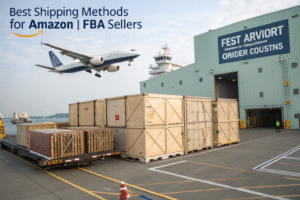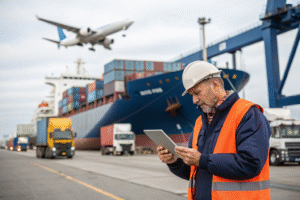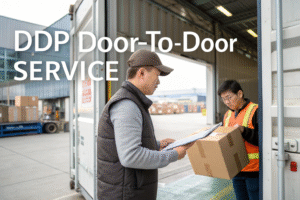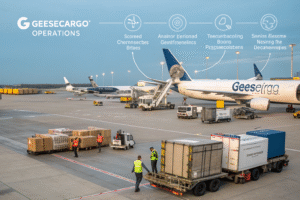August 2025’s tariff updates are hitting cross-border e-commerce sellers hard—especially those importing from Asia.
Whether you're selling on Amazon, Shopify, or your own store, the new import tax rules affect how you price, fulfill, and deliver goods. Many categories—like fashion, electronics, and accessories—now face 7–20% higher duties. The solution? You must realign your shipping strategy before peak season hits.
At GeeseCargo, we support dozens of e-commerce clients with DDP freight, customs coordination, and last-mile delivery into U.S. and EU warehouses. Based on these new tariffs, we’ve developed survival strategies to protect profit margins and maintain customer satisfaction.
How Do August Tariffs Affect E-Commerce Sellers Differently?
E-commerce sellers deal with low-margin, high-volume SKUs—making even a 5% duty hike painful.

The new tariffs are especially harsh on businesses relying on fast turnover and thin margins. With average import taxes rising from 11% to 17–20% on common e-commerce goods, your landed cost per product is changing—even if your supplier quotes haven’t.
Which Platforms Will Be Affected?
- Amazon FBA: Tariffs apply on inbound inventory to FBA centers. Duty misdeclaration can cause FBA bans.
- Shopify sellers: DDP is now more critical than ever to avoid last-mile disruptions.
- Etsy/eBay: Sellers handling their own fulfillment will need better customs compliance tools.
Read Amazon’s FBA import rules and Shopify shipping policies.
Are All Product Types Impacted?
No, but apparel, electronics, footwear, home goods, and accessories from China, Vietnam, and Bangladesh are on high-risk lists. Use HTS code lookups to check your SKUs.
Should You Switch to DDP Shipping for Small Parcels?
Yes. Delivered Duty Paid (DDP) service helps you absorb duties upfront and avoid customer-side delivery failures.

If you’re still shipping under DAP or EXW terms, your customers could be shocked by surprise duties at delivery. With DDP, all import taxes and clearance are prepaid by your forwarder—meaning fewer failed deliveries and complaints.
What Are the Pros of DDP for E-Commerce?
- Transparent pricing = easier product pricing
- Lower risk of customs holds
- Faster Amazon FBA check-in or warehouse stocking
Explore DDP parcel logistics to see how it works in multi-channel commerce.
Can DDP Work for Small Shipments?
Yes. We now offer ePacket-size DDP via express or consolidated air, optimized for Shopify and eBay sellers. Contact us for tailored small-parcel DDP quotes.
How Can You Reprice Your Products Without Losing Sales?
To preserve conversion, you need margin-based pricing automation and better tariff inclusion logic.

Many e-commerce businesses still price SKUs based on old landed costs. With August tariffs, your per-unit cost may be 12–18% higher—cutting directly into margin. You must reprice based on the new duty rates.
How Can You Automate This?
Use tools like:
- Intelligynce for competitive pricing insights
- Shopify Plus dynamic pricing apps
- Inventory Planner to track margin vs tariff impact
Should You Charge Customers for Import Tax?
No—this hurts conversion and increases disputes. Instead, include tariff costs in product pricing or shipping fee and offer “tax included” delivery at checkout.
How Do You Avoid Delays at Customs Under New Tariffs?
Most delays now stem from misclassified goods, missing documents, or unprepared declarations.

Under the new system, customs authorities are paying closer attention to value declarations and Section 321 exemptions. Mistakes or inconsistencies now lead to parcel holds or seizures.
What Are the Top Causes of E-Commerce Shipping Delays?
- Incorrect HTS code
- Underreported invoice value
- Missing Importer of Record (IOR) data
- Use of restricted trade terms (EXW)
How Do We Help Prevent This?
At GeeseCargo, we pre-screen each shipment through customs databases, verify product classifications, and offer an optional IOR service to help you clear parcels on behalf of your store.
Can You Reduce Tariff Exposure by Splitting or Bundling?
Recraft指令--Shipping strategy board showing parcel bundling to reduce per-SKU tax impact, warehouse scenes consolidating goods before export, and route optimization visuals. No text overlays, no distortion.
Yes—bundling low-value SKUs or splitting large imports across multiple hubs can lower effective duty.

Not all products are taxed the same way. Strategic shipping lets you classify, value, and split shipments more efficiently—especially if you're using consolidation or cross-dock services.
When Should You Bundle?
If you're shipping:
- 10+ small SKUs under $50
- Products to multiple states or countries
- Mixed category items (e.g., electronics + accessories)
When Should You Split?
- When SKU quantity or value exceeds De Minimis thresholds
- When using different shipping methods (e.g., express vs LCL)
- To avoid customs congestion at peak ports
Read about Section 321 bundling restrictions.
Conclusion
The August 2025 tariff update is not just about big container shipments—it will transform e-commerce fulfillment costs. Sellers must adopt smarter DDP shipping methods, reprice products based on new landed costs, and avoid customs penalties through proactive planning.
At GeeseCargo, we’ve built a complete freight solution for e-commerce sellers—combining DDP shipping, tariff simulation, customs handling, and small-parcel fulfillment support.
Email Ben Zhu at benzhu@geesecargo.com for a shipping strategy tailored to your e-commerce store before tariffs eat away your profit.









